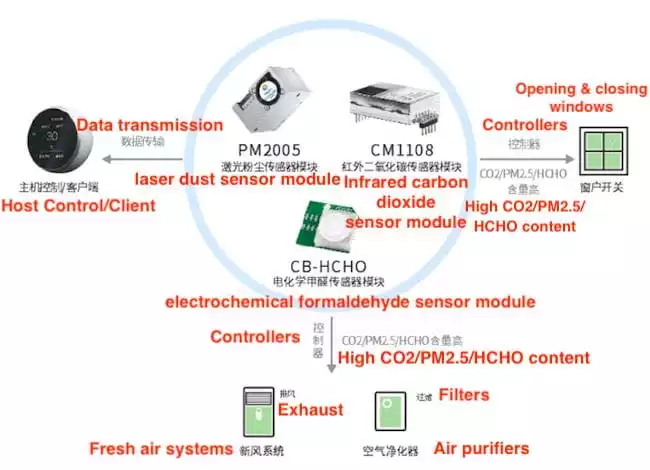With the invasion of smog, dust and industrial waste gas, the quality of air is becoming more and more serious, and it is imperative to improve indoor air monitoring. In recent years, the national air quality has deteriorated, and people are paying more and more attention to the quality of air to take necessary measures in a timely manner, especially those living in densely populated areas of big cities.
CO2 sensors
We all know that the content of carbon dioxide is a concern of many people. Excessive carbon dioxide content accumulates in the body, resulting in a drop in pH value, cellular hypoxia, and even some dysfunction. After the CO2 sensor detects the carbon dioxide content in the air, when the carbon dioxide content in the air exceeds a certain range, the air volume switch of the fresh air system can be controlled by the controller. The air volume switch of the fresh air system can be turned on to exhaust the air outdoors.
PM2.5 sensors
The PM2.5 sensor uses the principle of light scattering and particle counting technology to accurately detect the number of microparticles in the surrounding environment. After the PM2.5 sensor automatically detects the content of PM2.5 particles in the air, it can be displayed on the main computer and to the customer through software communication technology. It can also be applied in smart homes and intelligently linked with other devices. When the PM2.5 content in the air is too high, the PM2.5 sensor can be linked to control the window opener to close the window, and open the air purifier or fresh air system to purify the air, so that the living environment is always fresh and suitable.
Formaldehyde HCHO sensors
The formaldehyde HCHO sensor detects formaldehyde in the air through the principle of diffusion, and also has a certain degree of response to gases such as alcohols, benzene, and naphthalene. After detecting the concentration of formaldehyde in the air, the value can be displayed on the host or client through communication software technology, and it can also be intelligently linked with other devices in the smart home to control the switch of the air purifier or fresh air system to remove formaldehyde.

Applications of sensors in smart home environment monitoring
CO2 sensors
We all know that the content of carbon dioxide is a concern of many people. Excessive carbon dioxide content accumulates in the body, resulting in a drop in pH value, cellular hypoxia, and even some dysfunction. After the CO2 sensor detects the carbon dioxide content in the air, when the carbon dioxide content in the air exceeds a certain range, the air volume switch of the fresh air system can be controlled by the controller. The air volume switch of the fresh air system can be turned on to exhaust the air outdoors.
PM2.5 sensors
The PM2.5 sensor uses the principle of light scattering and particle counting technology to accurately detect the number of microparticles in the surrounding environment. After the PM2.5 sensor automatically detects the content of PM2.5 particles in the air, it can be displayed on the main computer and to the customer through software communication technology. It can also be applied in smart homes and intelligently linked with other devices. When the PM2.5 content in the air is too high, the PM2.5 sensor can be linked to control the window opener to close the window, and open the air purifier or fresh air system to purify the air, so that the living environment is always fresh and suitable.
Formaldehyde HCHO sensors
The formaldehyde HCHO sensor detects formaldehyde in the air through the principle of diffusion, and also has a certain degree of response to gases such as alcohols, benzene, and naphthalene. After detecting the concentration of formaldehyde in the air, the value can be displayed on the host or client through communication software technology, and it can also be intelligently linked with other devices in the smart home to control the switch of the air purifier or fresh air system to remove formaldehyde.

Applications of sensors in smart home environment monitoring
Previous: The Testing Principle of NDIR
Next: Detecting Dust




